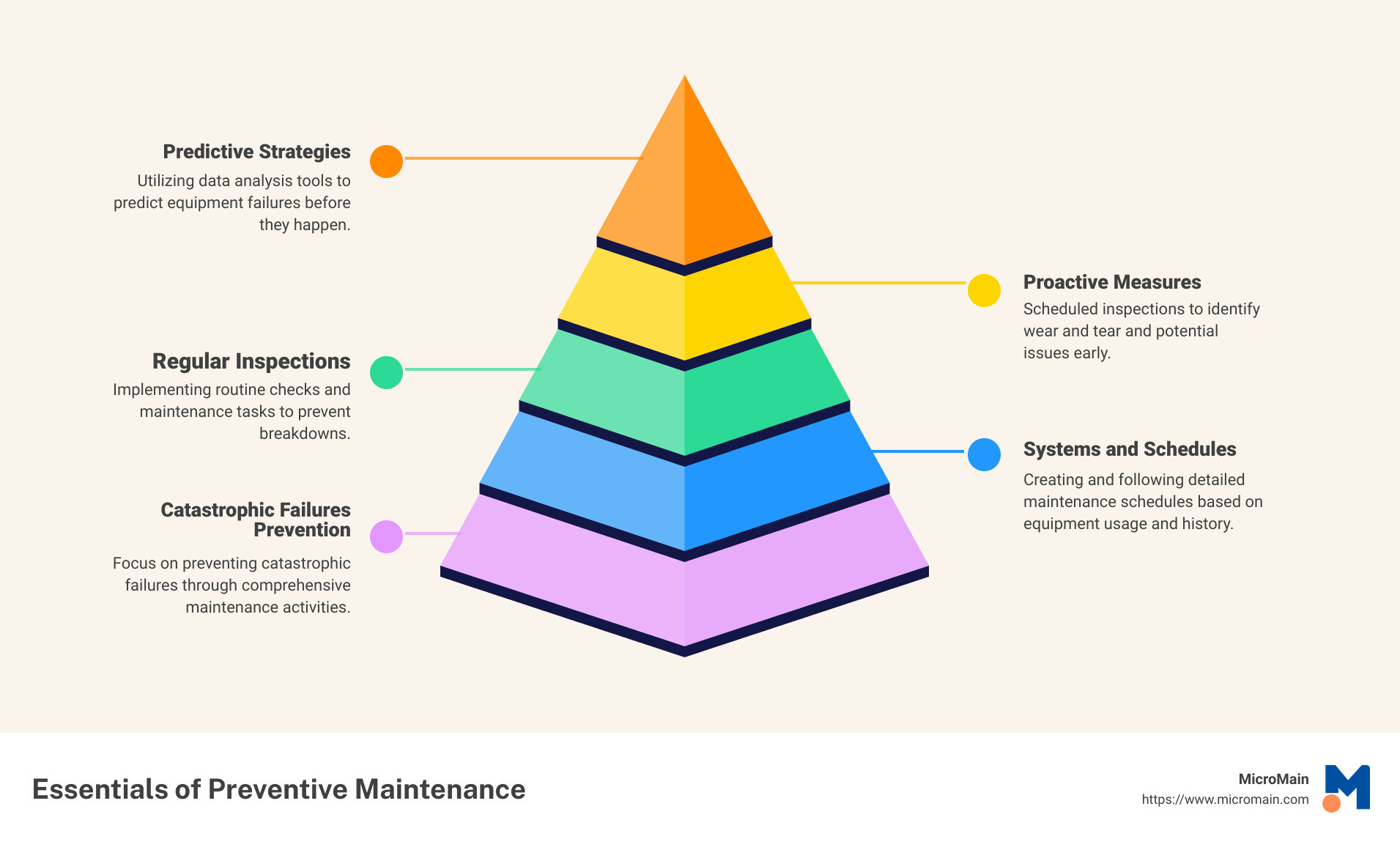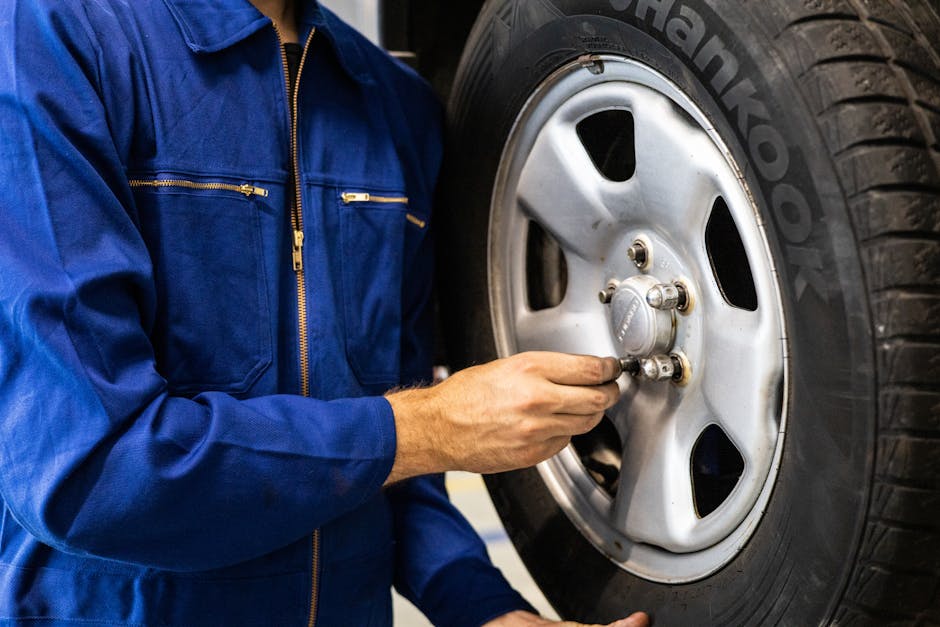Are you familiar with the mantra, "An ounce of prevention is worth a pound of cure?" If you're operating a manufacturing facility, you're likely well-acquainted with the financial and operational disruptions unplanned equipment downtime can cause. That's where the concept of preventing equipment failure rather than reacting to it comes into play. Welcome to preventive plant maintenance.
Understanding preventive plant maintenance is crucial to running your operations smoothly and cost-effectively. Preventive maintenance involves performing routine inspections, servicing, and repairing your plant's equipment based on a predetermined schedule. This proactive approach aims to catch potential issues early, minimizing the risk of sudden breakdowns that result in costly downtime.
Key Aspects of Preventive Maintenance
- Regular inspections and servicing of equipment.
- Systems and schedules are in place to execute these tasks.
- Predictive strategies for ongoing maintenance needs.
- Proactive rather than reactive measures to prevent catastrophic failures.
Preventive maintenance can be essential in improving worker safety, extending equipment lifecycles, and enhancing product quality. Given that your plant's equipment is under constant stress, a proactive strategy like this might be the difference between a well-oiled machine and a production nightmare.

As we dive deeper into this guide, we aim to help you understand, implement, and master preventive maintenance strategies from scratch. Whether you're assessing the total hours your equipment has run, performing vibration analysis, or deploying industrial maintenance software to automate tasks, our goal is to equip you with practical insights and steps to optimize your plant's operations, ensuring you're maximizing efficiency while keeping costs in check. Welcome aboard; let's get started!
Types of Preventive Maintenance
As we navigate preventive plant maintenance, we understand the various maintenance strategies we can employ. Different types of maintenance come with varying levels of risk, upfront costs, and labor requirements. Let's break down the five main types of preventive maintenance: time-based, failure-finding, condition-based, predictive, and risk-based.
Time-based Maintenance
Time-based maintenance is a traditional approach, often likened to scheduled machine maintenance. This strategy involves performing regular maintenance on equipment based on a predetermined timeline. It's like taking your car for an oil change every 5,000 miles. Time-based maintenance aims to prevent equipment deterioration or failure before it happens. However, it's worth noting that this method may lead to unnecessary maintenance if the equipment is still in good condition when the scheduled maintenance time arrives.
Failure Finding Maintenance
Failure-finding or corrective maintenance is designed to rectify faults identified during routine inspections or while operating the equipment. The goal is to prevent the problem from escalating and potentially causing a system failure. It's similar to noticing your car's brake pads are worn out during a routine service and replacing them before they cause an accident. At MicroMain, we consider corrective maintenance a planned activity because the fault is identified in a reasonable time frame and is not considered an emergency.
Condition-based Maintenance
Condition-based maintenance, as the name suggests, is performed based on the condition of the equipment. It employs meter readings and sensor alerts to determine when maintenance is needed. This strategy is akin to replacing your car's battery when it shows signs of wear and tear, not just because a certain amount of time has passed. Condition-based maintenance can be highly effective in preventing equipment failure as it targets the specific needs of each piece of machinery.
Predictive Maintenance
Predictive maintenance is a more evolved form of preventive maintenance. It uses historical data and advanced analytics to forecast when machines need maintenance. Consider using your car's past performance and other data to predict when it might need its next service. Predictive maintenance is a proactive approach to schedule corrective maintenance actions before a failure occurs. With the help of predictive maintenance models, we can make powerful predictions about when system failures will appear, allowing us to prevent them.
Risk-based Maintenance
Finally, there's risk-based maintenance. This strategy considers the potential risk a machine poses to business operations. It prioritizes maintenance tasks based on the severity of the possible failure. It's like fixing a car's faulty brakes before anything else because they pose the most significant safety risk. Risk-based maintenance aims to optimize maintenance and reduce reliability risks to plant or business operations.
Understanding these five types of preventive maintenance is the first step toward mastering preventive plant maintenance strategies. Each type has its strengths and is best suited to different scenarios. Adopting the right approach can significantly improve your plant's maintenance operations, reduce downtime, and boost productivity. In the next section, we'll delve into how to implement these strategies in your preventive maintenance plan.
Steps to Implementing Preventive Maintenance
Mastering preventive plant maintenance begins with a thorough understanding of its four fundamental steps: Inspection, Detection, Correction, and Prevention. By following these steps systematically, you can ensure your plant's assets operate at peak efficiency and reduce the risk of unexpected equipment failure.
Inspection: The First Step in Preventive Maintenance

The inspection phase involves regularly checking your plant's assets to assess their current condition. This is a critical step in preventive maintenance as it provides valuable insights into the equipment's performance and potential issues. Regular inspections can be carried out visually or using advanced tools such as ultrasonic detectors and infrared cameras, which offer more precise and accurate results.
Detection: Identifying Potential Issues
The detection phase involves analyzing inspection data to identify potential issues before they escalate into major problems. Using state-of-the-art tools like ultrasound and thermography can help detect early signs of machine failure, providing a larger window of opportunity for maintenance than traditional methods. Catching issues early prevents equipment failure and minimizes the risk of unplanned downtime, saving costs and resources.
Correction: Addressing Detected Issues
Once potential issues have been detected, the correction phase ensures these problems are addressed promptly. This includes necessary repairs or replacements to restore the equipment to its optimal condition. A reliable corrective maintenance strategy should consist of a system for reporting problems, providing technicians with detailed work orders, and scheduling remedial tasks efficiently. This ensures that the detected issues are addressed promptly and effectively, preventing further damage and ensuring the smooth running of operations.
Prevention: Avoiding Future Problems
The final step in preventive maintenance is prevention. This involves taking proactive measures to avoid future issues. This could mean adjusting the maintenance schedule based on the findings from the inspection and detection phases, or it could involve implementing more comprehensive measures such as upgrading equipment or retraining staff. By adopting a preventive mindset, your organization can significantly reduce significant costs associated with equipment failure and downtime.
Implementing these steps in your preventive maintenance plan will extend the life of your plant's assets and improve overall operational efficiency. At MicroMain, we understand the importance of preventive maintenance and provide comprehensive CMMS and EAM software solutions to help you manage your maintenance operations effectively. Our advanced tools and software solutions are designed to make the implementation of preventive plant maintenance strategies as smooth and efficient as possible.
Designing a Preventive Maintenance Program
In keeping with our commitment at MicroMain to help you achieve optimal operational efficiency, let's walk you through how to design a preventive plant maintenance program. This process involves determining your company's end goal, establishing equipment hierarchy, creating job plans, and scheduling maintenance tasks.
Determining the Company's End Goal
First, it's vital to understand your company's end goal. What do you hope to achieve by implementing a preventive maintenance program? Whether you aim to improve overall efficiency, reduce downtime, increase work completion rates, or ensure compliance, the tasks and procedures in your program should align with these organizational goals.
For instance, if your goal is to enhance efficiency, you might design your program to reduce downtime and boost work completion rates directly. If compliance is your main concern, you might focus on increasing planned maintenance and tracking labor.
Establishing Equipment Hierarchy
The next step is to establish an equipment hierarchy. This involves taking stock of all your equipment or fixed assets and creating a hierarchy structure. This structure will help you understand the relationship between the most critical machines and lower-ranking units. It lets you distinguish which equipment maintenance should be performed compared to tangible pieces or parts.
Creating an asset hierarchy involves considering factors like the total cost of ownership for each piece of equipment and the impact on safety should a component fail. At MicroMain, our asset management solutions can assist you with this process.
Creating Job Plans
Every preventive maintenance program should include job plans – a list of necessary resources to perform the maintenance work. A job plan should detail the scope of work, the tools and equipment needed, specific skills required, and a materials and parts list. It should also provide helpful information like photographs, diagrams, maps, standard operating procedures, and critical safety instructions. Job plans help organize labor, keeping employees controlled and efficient.
Scheduling Long-term and Short-term Maintenance Tasks
Finally, it would help if you planned your maintenance schedule. This involves deciding how often preventive maintenance tasks should be performed. Triggers for these tasks can be either time or usage-based, usually established through manufacturer recommendations or standard intervals applied to legacy equipment.
Our CMMS software can significantly assist in this step, providing tools to help prioritize and assign tasks, track their associated expenses over time, and automate work requests.
By following these steps, you'll be well on your way to mastering preventive plant maintenance strategies from scratch. The goal is to perform maintenance proactively and routinely to prevent failures before they occur. At MicroMain, we're here to support you every step of the way.
The Role of Technology in Preventive Maintenance
Technological advancements have revolutionized preventive plant maintenance, making it easier and more efficient. These tools are changing equipment maintenance and management from Computerized Maintenance Management Systems (CMMS) to IoT technology and AI.
The Use of CMMS Software in Scheduling and Task Generation
A Computerized Maintenance Management System (CMMS) is one of the most effective preventive plant maintenance tools. At MicroMain, we understand how crucial it is to have centralized and detailed records of all work done on your equipment, which is why we offer a powerful CMMS solution.
CMMS software allows for smart task generation and scheduling. This means it automates meter-based tasks for all your equipment, which can include detailed descriptions and how-to documents to ensure tasks are performed effectively. It also allows you to coordinate schedules based on labor resources and parts needed, setting up automatic task scheduling in line with time- or usage-based criteria.
The Impact of IoT Technology on Predictive Maintenance
The Internet of Things (IoT) has brought a new layer of sophistication to predictive maintenance. Sensor-integrated software, for instance, enables you to monitor multiple assets remotely. Multiple types of alerts for system monitoring and a variety of data graphs give you real-time information about things like temperature, vibration, and power quality.
IoT technology also allows for seamless workflows through mobile devices. Maintenance teams can respond to alerts from anywhere. They can access and respond to real-time work orders related to each alert.
How AI and Advanced Analytics Improve Operational Availability
Artificial Intelligence (AI) and advanced analytics have the potential to enhance preventive plant maintenance greatly. These tools can provide visualizations and gather analytical data to track the value and risks of each asset continuously. This data-driven approach can help prevent equipment malfunctions and optimize your maintenance schedule, leading to higher operational availability.
By integrating AI and analytics with your CMMS, you get valuable data on each piece of equipment, helping you develop a more effective preventive maintenance program.
In a nutshell, the role of technology in preventive plant maintenance is invaluable. It not only enhances efficiency but also helps in improving the reliability of your assets. As you continue on your journey to mastering preventive plant maintenance strategies, consider the power of these technological tools and how they can transform your maintenance operations.
Benefits of Preventive Maintenance
Preventive plant maintenance is more than a fancy term or an optional task. It brings tangible benefits to your plant operations, resulting in significant savings and improved efficiency. Let's dive into the key benefits you can expect when you implement a robust preventive maintenance strategy.
Decreased Downtime and Increased Equipment Life Expectancy
One of the most significant advantages of preventive maintenance is reduced downtime. By performing regular inspections and maintenance tasks, we can catch potential problems before they cause equipment breakdowns. According to a Plant Engineering maintenance study, 78 percent of facilities implementing a maintenance strategy switch to preventive maintenance, indicating a clear preference for proactive measures over reactive ones.
Moreover, preventive maintenance can significantly increase the lifespan of your equipment. Assets serviced regularly and kept in reasonable condition are less likely to fail unexpectedly, eliminating the need for premature equipment replacement.
Reduced Overtime Costs and Improved Safety for Employees
Unexpected equipment failure often results in overtime work to fix the issue and minimize production loss. However, with a well-planned preventive maintenance program, your employees work on a schedule, reducing overtime costs.
Moreover, preventive maintenance contributes to a safer work environment. Faulty equipment can create unsafe working conditions, which preventive maintenance can help avoid. It also ensures that your plant complies with Occupational Safety and Health Administration (OSHA) requirements.
Cost Savings and Improved Organization
Preventive maintenance can significantly reduce costs in the long run. It helps avoid large-scale repairs and the associated costs, saving you money.
Moreover, with preventive maintenance software like ours at MicroMain, you can organize and manage all your preventive maintenance tasks efficiently, saving time and resources. Our software allows you to store all your maintenance data in one place, making it easily accessible for your maintenance technicians.
In conclusion, preventive plant maintenance is a smart strategy for any manufacturing plant looking to improve efficiency, safety, and cost savings. It requires an initial investment of time and resources, but the long-term benefits make it worthwhile. The goal is not just to fix issues but to prevent them from happening in the first place.
Conclusion: Mastering Preventive Plant Maintenance Strategies
In conclusion, mastering preventive plant maintenance strategies means adopting a proactive approach, not a reactive one. It's about increasing equipment uptime, maintaining safety standards, and improving your bottom line. By understanding the different types of maintenance strategies and the role of technology, such as CMMS software, you can create a preventive maintenance program that works for your specific needs.
The key to success in preventive maintenance is planning. Having a clear plan is crucial, whether time-based, condition-based, or predictive. It's also important to continually reassess and refine this plan based on the current conditions of your equipment and the latest industry standards. The importance of documenting and recording your maintenance activities. This ensures everyone on your team is on the same page and provides valuable data for future planning and decision-making.
However, implementing preventive maintenance is not a one-time task but a continuous process. Regular inspections, timely detection of potential issues, and corrective actions are the bedrock of a successful preventive maintenance program. With a well-structured plan, you can minimize downtime, reduce costs, and ensure a safe and efficient working environment.
Moreover, training and education are key elements in your preventive plant maintenance strategy. Total productive maintenance involves everyone in the organization and can lead to continuous process improvement. It emphasizes the importance of training operators on essential equipment maintenance and operation and understanding the organization's maintenance goals and how they align with core business requirements.
At MicroMain, we understand the value of effective preventive maintenance and its role in reducing equipment downtime and maintenance costs. Our CMMS software is designed to simplify your maintenance planning and help you effectively implement your preventive maintenance strategies.
When it comes to preventive plant maintenance, it's not just about maintaining your equipment—it's about maintaining your business's productivity and profitability.
Contact us today to learn more about how we can help your organization improve its preventive maintenance practices. Let us help you make your equipment run longer, better, and faster.
 For immediate assistance, please call us at (512) 328-3235
For immediate assistance, please call us at (512) 328-3235




